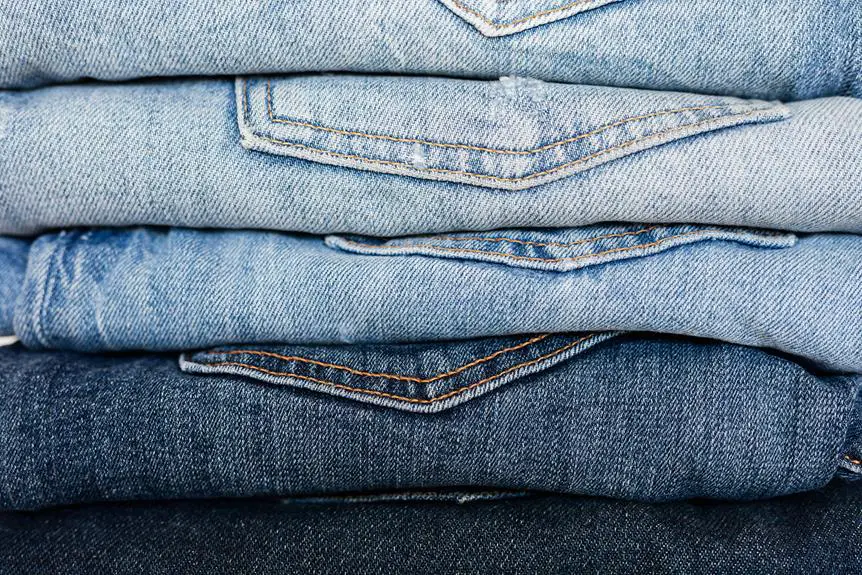When it comes to organizing your fabric collection, knowing where to start can be overwhelming. You've likely got a variety of materials, each requiring different storage methods to keep them in good condition. By assessing your fabrics and selecting the right storage solutions, you can transform your workspace into a more functional area. But what are the best techniques for maximizing space and ensuring easy access? Discovering the answers to these questions could change how you approach your craft.
Table of Contents
Key Takeaways
- Assess your fabric collection by evaluating each piece for usability and style relevance before organizing them by type or color.
- Choose suitable storage solutions that maximize space, like open shelving or clear bins, to enhance accessibility and organization.
- Utilize breathable materials like cotton or linen, and opt for airtight seals to preserve fabric integrity and prevent moisture buildup.
- Incorporate labels for easy identification of fabrics, using consistent systems to maintain organization as your collection changes.
Assessing Your Fabric Collection
Before diving into organization, take a moment to evaluate your fabric collection and determine what you truly need. Start by gathering all your fabrics in one spot. This will give you a clear view of what you have. As you sort through each piece, ask yourself a few questions: Do I love this fabric? Am I likely to use it in future projects? Does it fit my current style or needs?
Next, categorize your fabrics. You might group them by color, type, or project type. This step helps you see patterns in your collection. If you find you have multiple pieces of the same fabric or those you no longer love, consider letting them go. Donate or sell what you don't need; it'll clear up space and might even inspire others.
As you assess, take notes on the fabrics you want to keep and the ones you're ready to part with. This reflection not only simplifies your collection but also makes it easier when you start organizing.
Choosing the Right Storage Solutions
When you're choosing the right storage solutions for your fabric, start by assessing your space to see what fits.
Consider the materials of both your fabrics and the storage options, as this can impact longevity and accessibility.
Assessing Your Space
Assessing your available space helps you pinpoint the most effective fabric storage solutions that fit your needs. Start by measuring the dimensions of the area where you plan to store your fabrics. Consider the height, width, and depth to ensure you choose solutions that maximize your space without crowding it.
Next, think about how frequently you access your fabrics. If you use them often, opt for easily reachable storage options, like open shelving or bins that slide out. For less frequently used fabrics, consider high shelves or under-bed storage.
Don't forget to evaluate your organizational style. Do you prefer to see everything at a glance, or do you like to tuck items away? Clear containers provide visibility, while opaque boxes can create a clean look.
Lastly, consider any existing furniture. Can you repurpose a bookshelf or dresser, or do you need to invest in new storage solutions? By carefully assessing your space, you can choose storage options that aren't only practical but also enhance your overall organization, making it easier to keep your fabrics in great condition.
Material Considerations
Choosing the right materials for your storage solutions can significantly impact how well your fabrics are preserved and organized. With various options available, it's essential to select materials that protect your fabrics from damage while also fitting your space.
Here are three key materials to consider:
- Cotton or Linen: These natural fibers are breathable, preventing moisture buildup and mold. They're ideal for wrapping or storing delicate fabrics.
- Plastic Bins: Durable and stackable, plastic bins keep fabrics safe from dust and pests. Look for bins with airtight seals to further protect against humidity.
- Wooden Shelving: Sturdy and stylish, wooden shelves provide a beautiful way to display and store fabrics. Just ensure the wood is treated to avoid any chemical reactions with your fabrics.
Accessibility and Organization
To ensure your fabrics are both easily accessible and well-organized, consider using a combination of storage solutions that cater to your specific needs and space constraints. Start by evaluating your collection size and types of fabrics. Are you working with large bolts, smaller cuts, or remnants? This will influence your choice.
Here's a quick overview of storage options:
| Storage Solution | Best For | Pros |
|---|---|---|
| Clear Bins | Small to medium cuts | Easy visibility |
| Shelving Units | Large bolts | Maximizes vertical space |
| Hanging Organizers | All sizes | Saves floor space |
| Fabric Carts | All sizes, mobile needs | Portability |
Each solution has its advantages, so mix and match based on what you need. Clear bins and shelving units are ideal for visibility and accessibility, while hanging organizers work great in tighter spaces. Don't forget about labeling! A well-organized fabric stash not only saves time but also sparks creativity. Get started today, and you'll wonder how you managed without an organized system!
Shelving Systems for Fabrics
Effective shelving systems play a crucial role in keeping your fabric collection organized, accessible, and visually appealing. Whether you're a hobbyist or a professional, the right shelving can make all the difference. Here are three key benefits of investing in a solid shelving system for your fabrics:
- Maximized Space: Shelving units utilize vertical space, allowing you to store more fabric without cluttering your workspace. This makes it easier to keep everything within reach.
- Easy Visibility: Open shelving lets you see all your fabrics at a glance, helping you quickly find the right material for your projects. No more digging through piles!
- Customization: Many shelving systems are adjustable, letting you tailor the height and layout according to your needs. You can create a setup that perfectly fits your collection.
When selecting a shelving system, consider materials, durability, and design to ensure it complements your decor while serving a functional purpose.
Creative Bins and Boxes
When it comes to organizing your fabric, creative bins and boxes can make all the difference.
You can explore stylish storage options, create DIY fabric containers, and use labels for easy organization.
Let's explore how these solutions can elevate your space while keeping your materials easily accessible.
Stylish Storage Options
Creative bins and boxes not only keep your fabric organized but also elevate your décor with their stylish designs. You can transform your storage space into a chic display that reflects your personality.
Here are some stylish options to consider:
- Woven Baskets: These add a natural touch to your room. Choose ones with unique patterns or colors to make a statement while holding your fabric.
- Vintage Suitcases: Repurpose old suitcases as quirky storage solutions. They not only look great stacked or placed on shelves but also provide ample space for your fabric collection.
- Decorative Storage Boxes: Opt for boxes with bold prints or elegant textures. They come in various sizes and can easily be integrated into your home's design while keeping your fabric neatly concealed.
DIY Fabric Containers
Transform your fabric storage by crafting your own DIY containers that perfectly match your style and needs. You don't need to be a professional crafter to create functional and attractive bins.
Start by repurposing cardboard boxes or wooden crates; simply cover them with fabric or paint for a personal touch.
Next, consider using plastic containers with lids; you can easily customize them with fabric wraps or stickers. For a more rustic vibe, try adding burlap or twine to your bins. You can even sew fabric baskets using sturdy cotton or canvas; they're not only practical but also stylish.
If you're feeling ambitious, create modular shelving units from pallets. Stain or paint them to fit your decor, and add fabric bins for a cohesive look. Use small baskets to store scraps or trims, easily accessible and neatly contained.
Don't forget about the vertical space! Hanging fabric pockets on the wall can keep your smaller items organized while saving floor space.
With just a little creativity, you can build unique containers that showcase your fabric and enhance your crafting area. Get started today, and let your imagination guide you!
Labels for Organization
Adding labels to your DIY bins and boxes not only enhances organization but also helps you quickly find what you need in your fabric storage. Without labels, you might waste valuable time rummaging through containers, leading to frustration.
Here are three simple steps to create effective labels for your storage:
- Choose a Consistent Style: Decide on a font and color that matches your decor or personal taste. Consistency makes your storage look polished.
- Be Specific: Instead of vague terms like 'fabric,' use precise labels such as 'Cotton Prints,' 'Silk Blends,' or 'Quilting Fabrics.' This specificity helps you locate items at a glance.
- Utilize Clear Materials: Use clear plastic pockets or chalkboard labels for easy updates. This way, you can change the labels as your fabric collection evolves.
With these steps, you'll not only keep your fabric organized but also create a visually appealing storage solution.
Rolling Vs. Folding Techniques
When it comes to fabric storage, choosing between rolling and folding techniques can significantly impact how much space you save and how easily you access your materials.
Rolling your fabric is often the favored method among quilters and crafters because it maximizes space and minimizes wrinkles. When you roll your fabric, you can fit more pieces into a drawer or bin, and it's easier to see what you have at a glance. Plus, rolled fabric tends to take up less vertical space.
On the other hand, folding your fabric can help keep it organized and more structured. If you prefer to stack your fabric, folding might be your best bet. It allows for neat stacks that are easy to label and access. However, folded fabric can sometimes lead to creasing, especially if it's stored for an extended period.
Ultimately, the best technique depends on your storage space and personal preference. Consider your fabric types and how often you use them. Experiment with both methods to see which works best for your needs and keeps your fabric collections in great shape!
Utilizing Closet Space Effectively
Maximize your closet space by implementing smart organization strategies that make accessing your fabric a breeze. The key lies in using every inch effectively, ensuring your fabrics aren't just stored but are also easy to reach.
Here are three effective ways to utilize your closet space:
- Vertical Storage: Use vertical space by adding shelves or stackable bins. This helps you store more fabrics without taking up floor space. Consider installing a tension rod for hanging fabric rolls, making them easy to see and grab.
- Clear Containers: Opt for clear storage bins to keep your fabric organized and visible. This way, you won't waste time digging through boxes to find what you need. Label each container with a general category to streamline your search.
- Hanging Organizers: Use hanging organizers on the inside of your closet doors. These can store smaller fabric pieces, tools, and supplies, keeping them accessible but out of the way.
Labeling and Organizing Tips
Organizing your fabric collection becomes effortless with a solid labeling system that ensures you can quickly find exactly what you need. Start by categorizing your fabrics by type, color, or project. Use clear, concise labels to identify each category. Consider using a combination of printed and handwritten labels to add a personal touch.
Here's a simple way to visualize your organization:
| Category | Label Example |
|---|---|
| Cotton Fabrics | Cotton – Floral |
| Upholstery Fabrics | Upholstery – Stripes |
| Specialty Fabrics | Specialty – Sequins |
You can use clear bins or boxes to store your fabrics, and place the labeled categories on the front for easy access. If you're short on space, consider using a color-coded system on your labels, which allows you to quickly identify sections at a glance.
Lastly, keep a small notebook or digital document detailing your fabric inventory. This will save you time and frustration when you're searching for that perfect piece. With these tips, you'll enjoy a more organized and efficient fabric storage solution.
Frequently Asked Questions
How Do I Maintain Fabric Quality During Storage?
To maintain fabric quality during storage, keep your materials in a cool, dry place. Avoid direct sunlight and moisture, and use breathable storage bags. Regularly check for pests and air out your fabric to prevent mustiness.
Are There Specific Fabrics That Require Special Storage Conditions?
Yes, some fabrics need special storage. Wool, silk, and leather require breathable bags or containers to prevent mold and damage. Always keep them in a cool, dry place away from direct sunlight to maintain their quality.
Can I Store Fabrics in a Damp Environment?
You shouldn't store fabrics in a damp environment. Moisture can lead to mold and mildew, damaging your fabrics. Instead, choose a cool, dry place to ensure your textiles remain in great condition for longer.
What Are the Best Practices for Storing Vintage Fabrics?
When storing vintage fabrics, keep them in a cool, dry place away from direct sunlight. Use acid-free tissue paper to wrap pieces, and avoid plastic bags to prevent moisture buildup and preserve their integrity.
How Often Should I Reassess My Fabric Storage Solutions?
You should reassess your fabric storage solutions at least twice a year. Regularly checking helps you spot any issues, adapt to your changing needs, and ensure your fabrics remain in excellent condition for future projects.
- Sourcing Viscose Fabric: Top Producers in Bangladesh - June 21, 2025
- Where to Find High-Quality Shirt Fabric in Bangladesh - June 21, 2025
- Current Satin Fabric Price in Bangladesh for Garments and Decor - June 21, 2025






